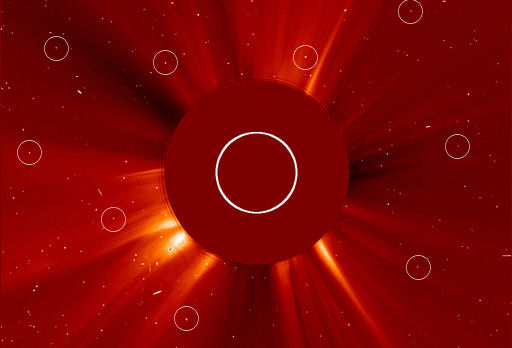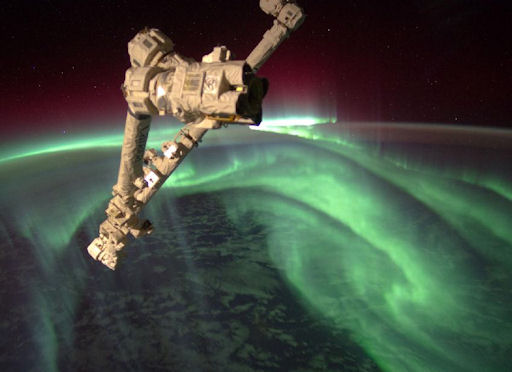MARTIAN MARATHON: More than 8 years after landing on the Red Planet, Mars rover Opportunity is still running. Indeed, mission planners say the tireless robot is poised to complete a full marathon--the first ever long-distance race on an alien planet. [full story] [video]
RADIATION STORM: A low-level radiation storm is underway as solar protons swarm around our planet. Ranked S1 on NOAA space weather scales, the storm poses no serious threat to astronauts or satellites. Nevertheless it is a nuisance. Minor radiation storms can cause occasional reboots of computers onboard spacecraft and add "snow" to spacecraft imaging systems. This SOHO coronagraph image of the sun, taken during the early hours of July 20th, is a good example:
Each of the speckles in the image (a handful are circled) are caused by protons hitting the spacecraft's CCD camera. During minor storms it is possible to see through this kind of snow. During severe storms, such images become practically opaque.
The protons were accelerated toward Earth by an M7-class solar flare on July 19th. Although the blast site (sunspot AR1520) was on the farside of the sun, the protons were able to reach Earth anyway, guided toward our planet by backward-spiralling lines of magnetic force. Solar flare alerts: text, voice.
Realtime Space Weather Photo Gallery
SOUTHERN LIGHTS: The geomagnetic storm of July 14-16 was remarkable for the beauty of its auroras in the southern hemisphere. The view was especially good from above the southern hemisphere:
Astronaut Joe Acaba photographed these Southern Lights from the International Space Station on Saturday, July 14th. He was 400 km above Earth's surface, immersed in the fringes of the auroras themselves.
"It was absolutely incredible," says Acaba. "I was working out and in between sets I noticed that we were heading south during a night pass. So I decided my workout could be postponed for a few minutes and I turned out all of the lights in Node 3. Within a couple of minutes, I could not believe what I was seeing. I enjoyed the show for a few minutes [then alerted my crewmates to look].. Even Gennady, with all of his time on orbit, was amazed. Of course I took some obligatory pictures, but then I just sat in the dark, in the peace and quiet of this incredible man made, orbiting laboratory and just looked out the window in awe. What a truly magnificent planet we live on and solar system we live in."
Solar wind
speed: 423.8 km/sec
density: 4.8 protons/cm3
explanation | more data
Updated: Today at 1457 UT
![]()
X-ray Solar Flares
6-hr max: B5 0801 UT Jul20
24-hr: B7 0027 UT Jul20
explanation | more data
Updated: Today at: 1400 UT
![]()
![]()
![]()
Daily Sun: 20 Jul 12
![]()
![]()
None of the spots on the Earth-facing side of the sun pose a threat for strong flares. Credit: SDO/HMI
![]()
![]()
![]()
Sunspot number: 39
What is the sunspot number?
Updated 20 Jul 2012
Spotless Days
Current Stretch: 0 days
2012 total: 0 days (0%)
2011 total: 2 days (<1%)
2010 total: 51 days (14%)
2009 total: 260 days (71%)
Since 2004: 821 days
Typical Solar Min: 486 days
Updated 20 Jul 2012
The Radio Sun
10.7 cm flux: 110 sfu
explanation | more data
Updated 20 Jul 2012
![]()
![]()
![]()
Current Auroral Oval:
![]()
Switch to: Europe, USA, New Zealand, Antarctica
Credit: NOAA/POES
![]()
![]()
![]()
Planetary K-index
Now: Kp= 3 quiet
24-hr max: Kp= 3 quiet
explanation | more data
![]()
Interplanetary Mag. Field
Btotal: 6.5 nT
Bz: 5.8 nT south
explanation | more data
Updated: Today at 1457 UT
![]()
![]()
![]()
Coronal Holes: 18 Jul 12
![]()
![]()
A solar wind stream flowing from this coronal hole should reach Earth on or about July 21st. Credit: SDO/AIA. ![]()






